“Van living” or “van life” is an emerging trend that has been growing in popularity around the US. Yahoo Finance estimates that the number of vanlifers has grown by at least 63% over the last handful of years.
It appears more folks are turning vans or buses into tiny homes on wheels and hitting the road full time. Thanks to social media, #vanlife looks idyllic – but who wouldn’t want to wake up to mountain views every morning! It’s dreamy!
But is this barebones, mobile lifestyle truly sustainable for the planet?
Evaluating the Eco-Scorecard
On one hand, van lifers consume way fewer resources. Small spaces mean limited energy for heating and cooling. Rooftop solar panels provide electricity and water tanks get refilled only when needed.
This lightweight living uses a fraction of what the average American home gulps down. A vanlifer rarely spends similar amounts as living in an apartment.
Typical expenses of a vanlifer would include groceries, gas, laundry and sometimes, gym memberships to access the showers. A 300-watt solar panel can power a rice cooker, toaster oven, coffee pot, toothbrush, laptop, cellphone and electric shaver, among other equipment.
The van is a tiny home, and you’ll not be needing to heat or cool a big place. That means less carbon footprint than most people.
But many older vans guzzle gas, especially lumbering around all day seeking boondocking sites. Newer conversions to high-mpg hybrids or electric help, but aren’t the norm yet. And even eco-vans still require manufacturing and materials. Don’t they?
The Takeaway
While not 100% green, van living reflects growing anti-consumerism sentiment. Trading McMansions for just the essentials of a modest mobile pod reduces waste.
But this unicorn of sustainability still has some warts. For now, #vanlife lands somewhere in the middle on the eco-scorecard. At least nomads are driving in the right direction – literally and philosophically!







